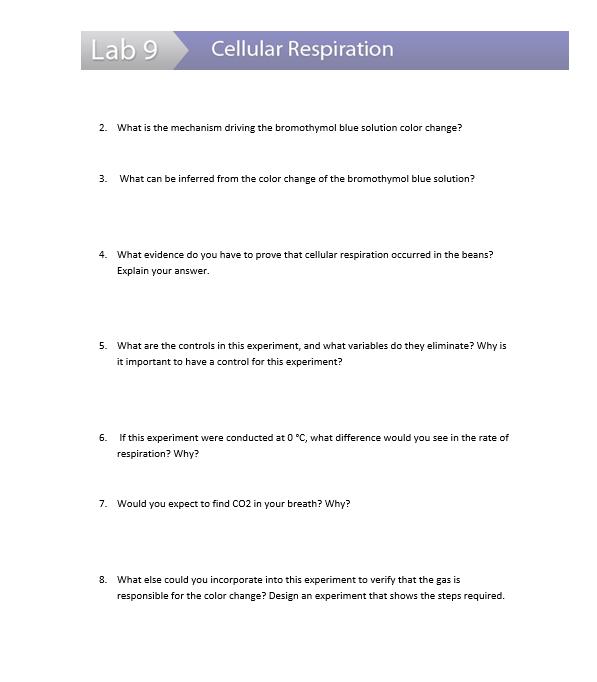We will evaluate respiration in beans by comparing carbon dioxide production between germinated and n9ngerminated, beans. As shown in the balanced equation for cellular




We will evaluate respiration in beans by comparing carbon dioxide production between germinated and n9ngerminated, beans. As shown in the balanced equation for cellular respiration, one of the byproducts is CO: (carbon dioxide): CeH20s + 6 H20 + 6 0, > energy + 6 CO, + 6 H20 We will use a carbon dioxide indicator (bromothymol blue) to show oxygen is being consumed and carbon dioxide is being released by the beans. Bromothymol blue is an indicator that turns yellow in acidic conditions, green in neutral conditions, and blue in basic conditions. When carbon dioxide dissolves in water, carbonic acid is formed by the reaction: H,0 + Co, > H,CO, resulting in the formation of this weak acid. If an indicator such as bromothymol blue is present, what do you think would happen? (Hint - what color would the indicator change to?) Materials (6) 250 ml Beakers 24 mL Bromothymol Blue Solution, CaHzBr,0,S 1 Pipette 6 Rubber Bands (Large. Contains latex; please handle with gloves if you have a latex allergy.) 100 Kidney Beans 6 Medicine Cups (small, clear, plastic cups) 15 cm Parafilm *Water *Paper Towels Permanent Marker 100 Pinto Beans *You Must Provide Procedure: 1. Label two of the 250 mL beakers as Soaked: Pinto and Soaked: Kidney. Lab 9 Cellular Respiration 2. Fill each beaker with 200 mL water. 3. Count and transfer 50 pinto beans into the Soaked: Pinto beaker. Then, count and transfer 50 kidney beans into the Soaked: Kidney beaker. Allow the beakers to rest for 24 hours. 4. After 24 hours have passed, carefully strain the water from each beaker. 5. Place two paper towels on a flat work surface. Use the permanent marker to label one paper towel as Soaked: Pinto and the second as Soaked: Kidney. 6. Pour the soaked beans onto paper towels, keeping them sorted by bean type. 7. Label the remaining beakers as Dry: Pinto, No Pinto, Dry: Kidney, and No Kidney. 8. Place several layers of moist paper towels at the bottom of all six, 250 ml beakers. 9. Place 50 pre-soaked pinto beans into the Soaked: Pinto beaker, 50 unsoaked pinto beans into the Dry: Pinto beaker, and no beans into the No Pinto beaker. 10. Place 50 pre-soaked kidney beans into the Soaked: Kidney, 50 unsoaked kidney beans into the Dry: Kidney beaker, and no beans into the No Kidney beaker. 11. Dispense four ml of bromothymol blue solution into each of the six measuring cups. Then, place one cup inside each beaker (Figure 5). 12. Stretch Parafilm across the top of each beaker. Secure with a rubber band to create an air-tight seal. Note: If your Parafilm seal mo breaks, plastic wrap (such as Saran wrap) can be used as a replacement. Figure 5: The image above shows what the beans, beaker, and measuring cup set-up should look like. 13. Place the beakers on a shelf or tahle and let sit undisturbed at room temperature. 14. Record the initial color of the bromothymol solutions and observe the jars at 30. minute intervals for three hours. Record the color of the bromothymol blue in Tables 2 and 3. 15. Let the beans and the jar sit overnight. Record your final observations in Tables 2 and 3. Lab 9 Cellular Respiration Table 2: Bromothymol Blue Color Change Over Time for Pinto Bean Trial Time Pre-Soaked Pinto Beans Dry Pinto Beans No Pinto Beans O min 30 min 60 min Blue Blue Blue Bluish green Blue Blue Green Blue Blue 90 min Bright Green Blue Blue 120 min Bright Green Blue Blue Light Green Yellowish green 150 min Blue Blue 180 min Blue Blue 24 hours Yellow Blue Blue Table 3: Bromothymol Blue Color Change Over Time for Kidney Bean Trial Time Pre-Soaked Kidney Beans Dry Kidney Beans No Kidney Beans O min Blue Blue Blue 30 min Bluish green Blue Blue 60 min Green Blue Blue Bright Green Bright Green 90 min Blue Blue 120 min Blue Blue 150 min Blue Light Green Yellowish green Blue 180 min Blue Blue 24 hours Yellow Blue Blue Post-Lab Questions 1. How did the color of the bromothymol blue solution in each beaker change over time in each condition? Lab 9 Cellular Respiration 2. What is the mechanism driving the bromothymol blue solution color change? 3. What can be inferred from the color change of the bromothymol blue solution? 4. What evidence do you have to prove that cellular respiration occurred in the beans? Explain your answer. 5. What are the controls in this experiment, and what variables do they eliminate? Why is it important to have a control for this experiment? 6. this experiment were conducted at 0 C, what differer you see in the rate of respiration? Why? 7. Would you expect to find CO2 in your breath? Why? 8. What else could you incorporate into this experiment to verify that the gas is responsible for the color change? Design an experiment that shows the steps required.
Step by Step Solution
3.35 Rating (155 Votes )
There are 3 Steps involved in it
Step: 1

See step-by-step solutions with expert insights and AI powered tools for academic success
Step: 2

Step: 3

Ace Your Homework with AI
Get the answers you need in no time with our AI-driven, step-by-step assistance
Get Started


